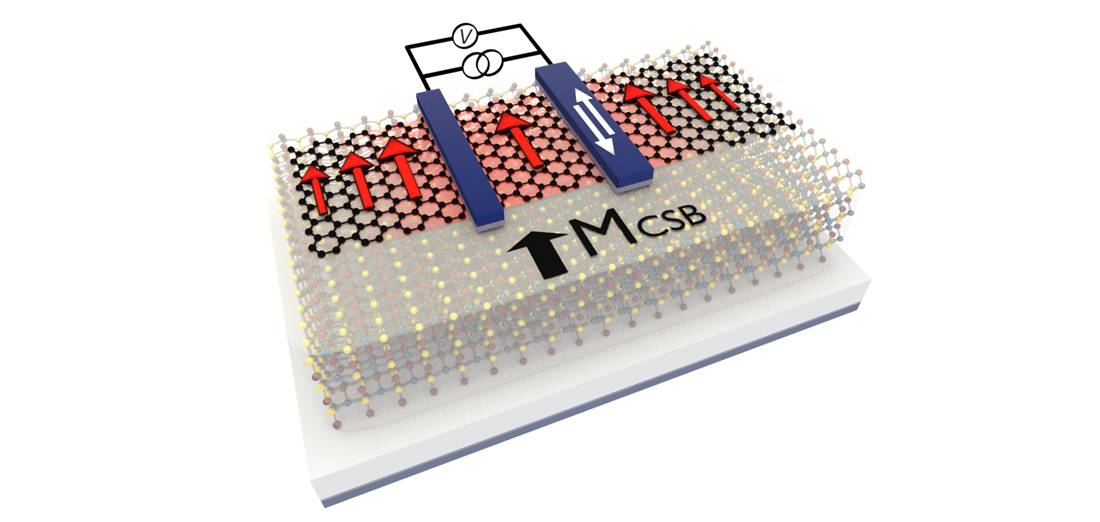Towards ultra-compact spin-logic circuitry with magnetic graphene
Spin polarisation has been introduced to graphene without a ferromagnet for the first time.
Graphene Flagship researchers have imbued graphene with magnetic properties, without requiring a bulky ferromagnet or large electrodes, for the first time. This makes the material ideal for applications in spintronics: a technology that holds the key to more efficient information transfer and data storage.
Scientists at Graphene Flagship partner the University of Groningen, the Netherlands, in collaboration with Columbia University, USA, have developed a method to make graphene an ideal generator and host of spin currents, which could lead to next-generation applications in computer processing and data storage.
The demand for smaller, faster and more energy efficient circuits is ever on-the-rise, and spintronics could be the answer. Devices based on spintronics technology could be viable alternatives to current electronics, and incorporating layered materials like graphene could improve spin polarisation and enable the long-distance transfer of spin information for computing purposes.
“With the support of the Graphene Flagship, within the Spintronics Work Package, we showed that we can introduce an exchange interaction to graphene without the need for a large ferromagnet,” begins Bart van Wees, from Graphene Flagship partner the University of Groningen and co-author of the paper, published in Nature Nanotechnology. This could be a breakthrough for graphene-enabled spintronics devices.
Electrons in a material have an intrinsic property called ‘spin.’ This is effectively a magnetic moment caused by the material’s electrons rotating, like a spinning top. Spin can only go one way or the other, so it has two distinct states, known as ‘spin up’ and ‘spin down’. Non-magnetic materials have an equal proportion of both states, but an imbalance causes a material to become magnetic. This phenomenon is called spin polarisation.

Caption: Schematic of the studied device, showing the electrical and thermal generation of spin currents in a bilayer graphene/CrSBr heterostructure. The magnetic cobalt electrodes are used to determine the proximity induced spin polarisation in the bilayer graphene, whereas the magnetisation of the outermost layer of CrSBr (MCSB) allows for higher conductivity of the spin-up electrons (red arrows). Credit: Talieh S. Ghiasi
“We decided that the next step for our research was to put graphene onto a piece of a layered antiferromagnet, using a material called chromium bromium sulfide, or CrSBr,” explains van Wees. Simply by ‘sticking’ graphene, in the literal sense, on top of this antiferromagnetic material, the researchers introduced spin polarisation to graphene. For the first time, this was done without needing to pass the current through an external ferromagnet.
When asked why this effect occurs, van Wees describes how graphene actually ‘feels’ the proximity of the first layer, causing an imbalance between up and down spin states. In fact, with their setup, about 60% of the electrons are ‘spin up’ and 40% are ‘spin down.’ He explains that this level of spin polarisation is comparable to a metallic ferromagnet, which was never demonstrated for graphene before. “This is very technologically relevant, as it introduces the possibility to transfer magnetic information to and from graphene. This is the basis for sensors that read data from a computer hard drive, for instance,” van Wees continues.
The strong spin-polarisation of conductivity in the magnetic graphene, furthermore, gives rise to the thermal generation of a spin current, which turns heat dissipation into an opportunity to manipulate spin information. “The electrical and thermal generation of spin currents by magnetic graphene allows for spin-logic circuitries where spin injection, transport and detection are all done by graphene itself. This can lead to substantial advances in ultra-compact spintronics and spin-caloritronics technology,” explains Talieh Ghiasi, the first author of the paper, also from Graphene Flagship partner the University of Groningen, the Netherlands.
Stephan Roche, Graphene Flagship Work Package Leader for Spintronics, comments: “This work is a new milestone for the field of spintronics based on layered materials. This is evidence that the new class of emerging layered magnetic materials presents formidable opportunities, when interfaced with other layered materials such as graphene, to generate efficient spin device functionality which could impact on new memory or computing paradigms. The Spintronics Work Package leads, on the international scene, the exploration of the potential of layered materials for disruptive spintronics applications. Bart van Wees and his group are playing a key role in pushing the frontier of knowledge beyond the state-of-the-art”
Andrea C. Ferrari, Science and Technology Officer of the Graphene Flagship and Chair of its Management Panel, adds: “This work represents another key step for the translation of the opportunities of graphene and layered materials in spintronics. This new technology will be developed further throughout Core 3, the current funding phase of the Graphene Flagship project, and lays the foundations for new opportunities to be explored in Horizon Europe.”
References
Ghiasi, Talieh S., et al. "Electrical and Thermal Generation of Spin Currents by Magnetic Graphene." Nature Nanotechnology (2021): https://dx.doi.org/10.1038/s41565-021-00887-3.




